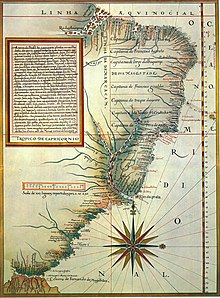Captaincy
A captaincy ( port. : Captaincy , span. : Capitanía ) was an administrative unit in the former Spanish and Portuguese colonial empires .
Captains in Brazil

Legend: Capitania de Ioao de Barros, Capitania de Françisco barreto, Capitania de Iorge dalbuquerqe, DE SVA MAGESTADE, Capitania de Françisco Giraldes, Capitania do Duque daveiro, Capitania de Vasco frz Coutinho, Capitania de Pero de goes, Capitania de Lopo de Sousa
Even before the discovery of Brazil, the Portuguese crown awarded newly discovered areas to Capitães , such as the Azores , Madeira and areas on the coast of Africa . Of greater importance were the captains, which were established there after the discovery by Pedro Álvares Cabral in 1500 (the country was initially called Terra de Santa Cruz ). The area was claimed by Portugal because it was east of the border line with the Spanish colonial empire agreed in the Treaty of Tordesillas . The land was now given as a kind of fiefdom to Portuguese nobles, the Capitães-Mor. There were a total of 15 such captains, separated from each other by borders running parallel to the equator to the demarcation line of Tordesillas. The location and size of the captains was determined in 1534 by the Portuguese King John III. established, although there were only 12 Capitães-Mor, as some of them were given the rule of several captains. In detail, it concerned the following areas or Capitães-Mor:
| Captaincy | Capitão-Mor |
|---|---|
| (1.) Maranhão captaincy | Fernão Aires |
| (2.) Maranhão captaincy | João de Barros |
| Captaincy of Ceará | Antônio Cardoso de Barros |
| Rio Grande captaincy | João de Barros / Aires da Cunha |
| Itamaracá captaincy | Pero Lopes de Sousa |
| Pernambuco captaincy | Duarte Coelho Pereira |
| Bahia Capitol | Francisco Pereira Coutinho |
| Captaincy of Ilhéus | Jorge de Figueiredo Correia |
| Porto Seguro captaincy | Pero Campos de Tourinho |
| Capitanate of Espírito Santo | Vasco Fernandes Coutinho |
| São Tomé captaincy | Pero de Góis da Silveira |
| São Vicente captainate - first section between Paraty and Cabo Frio | Martim Afonso de Sousa |
| Santo Amaro captaincy - section between Bertioga and Paraty | Pero Lopes de Sousa |
| São Vicente captaincy - Second section between Cananéia and Bertioga | Martim Afonso de Sousa |
| Santana captaincy between Cananéia and Laguna | Pero Lopes de Sousa |
Except for two of these captains, none of them had a long lifespan. The Kapitanat Pernambuco was successful because of the local cultivation of sugar cane and was later converted into the viceroyalty of Grão-Pará. The São Vicente captaincy proved successful through the expeditions of the so-called Paulistani into the hinterland (these advances were called Bandeiras ), during which they discovered the precious metals and precious stones of Brazil and hunted "Indians" to sell them as slaves.
Spanish captains
- Captain General Puerto Rico (1580)
- New Spain (1524), from 1535 viceroyalty
- Peru (1528), from 1542 viceroyalty
- Santo Domingo (1540)
- General captainate of Chile , was created in 1541 after the Arauco War . Initially part of the Viceroyalty of Peru, it became an autonomous general captainate in 1789
- General Capitanate Guatemala (1609)
- Captain General Yucatán (1564), including Campeche and Quintana Roo
- Spanish East Indies (1565)
- New Granada (1563), from 1717 Viceroyalty (1717).
- Captain General Cuba (1764), including Louisiana Territory acquired by France in 1763 and Spanish Florida after 1784
- General captainate of Venezuela , split off from New Granada in 1777
- Provincias internals , 1776 as an autonomous region within New Spain created